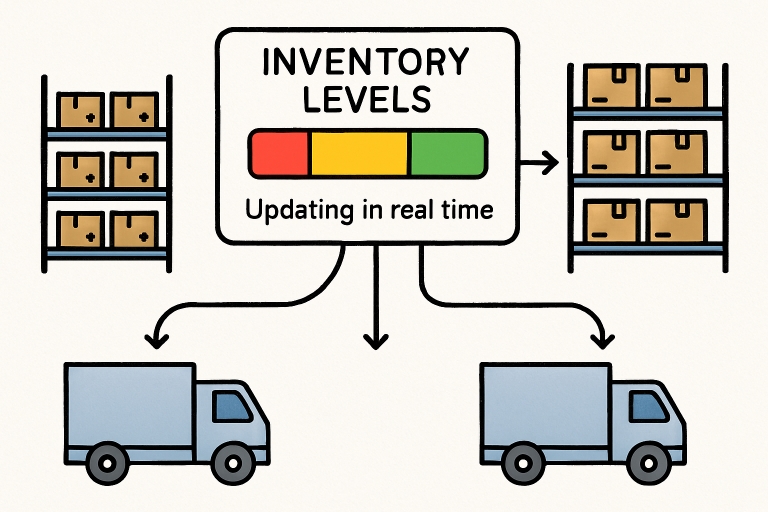Key Takeaways
- Real-time inventory management enables continuous stock tracking, minimizing stockouts and reducing excess inventory.
- Technology-driven systems improve supply chain visibility, operational efficiency, and demand forecasting accuracy.
- Adopting proactive inventory strategies is essential for staying competitive in fast-paced industries like healthcare and manufacturing.
- Investing in real-time inventory fosters stronger supplier relationships and sustainable business growth.
Table of Contents
- Understanding Real-Time Inventory Management
- Benefits of Real-Time Inventory Systems
- Implementing Real-Time Inventory for Proactive Resupply
- Challenges and Considerations
- Future Trends in Inventory Management
- Final Thoughts
Understanding Real-Time Inventory Management
In today’s competitive supply chain landscape, businesses increasingly rely on real-time inventory management systems to monitor and optimize their stock. These systems use advanced technologies such as barcode scanning, RFID tags, and cloud-based software platforms to provide up-to-the-minute data on inventory status. From retail to medical resupply operations, the ability to instantly access accurate inventory data is critical for reducing delays and maximizing efficiency.
The shift from traditional periodic reviews to continuous, automated inventory tracking revolutionizes stock handling. Real-time updates allow organizations to see exactly what is available, where it is located, and how quickly it moves through the supply chain. As industries like healthcare and manufacturing face mounting pressure to ensure timely resupply of essential goods, leveraging real-time systems has become a business imperative. By embracing solutions that centralize and automate inventory oversight, teams ensure that essential items are always within reach.
Benefits of Real-Time Inventory Systems
- Enhanced Visibility: Full transparency across multiple warehouses and supply chain nodes helps organizations maintain control over assets and avoid lost or misplaced items.
- Faster Response Times: Decision-makers can respond swiftly to demand fluctuations or unexpected changes, supporting a more agile and reliable operation.
- Improved Demand Forecasting: When paired with advanced analytics, real-time data fuels smarter predictions, enhancing the accuracy of both short-term ordering and long-range planning.
- Reduced Overstock and Stockouts: Precise inventory monitoring makes it easier to maintain balanced stock levels, which cuts costs and keeps customers satisfied.
- Streamlined Operations: Integrated inventory systems break down silos between departments, supporting smooth workflows and reducing manual errors.
- Stronger Supplier Relationships: Reliable stock data fosters proactive supplier communication, improving lead times and minimizing disruptions.
- Cost Savings: Avoiding excess inventory means lower storage and insurance costs, freeing up capital for other priorities.
Real-time inventory management is also a key component of robust risk management strategies. By instantly identifying potential supply interruptions and adjusting orders accordingly, organizations can mitigate the impact of unexpected events. This capability is particularly vital in industries where supply chain continuity is critical, such as pharmaceuticals and food distribution.

Implementing Real-Time Inventory for Proactive Resupply
Shifting to a proactive resupply strategy requires the right technology and a thoughtful integration process. Here are essential strategies for realizing the benefits of real-time inventory management:
- Automated Reordering Systems: Deploy software that monitors inventory thresholds and places orders automatically as stock reaches predetermined levels. Artificial intelligence (AI) and machine learning can adapt these triggers based on trends, optimizing order timing and quantities.
- AI-Driven Demand Forecasting: Machine learning tools analyze historical sales data, supplier trends, and production cycles to accurately predict future stock requirements. This proactive approach helps prevent shortages and surpluses, aligning inventory with anticipated needs.
- Real-Time Stock Tracking: Internet of Things (IoT) sensors, smart shelving, and wireless inventory technologies deliver instant feedback on stock status. Automated systems synchronize data across all touchpoints, supporting a unified view of the supply chain.
Businesses making the transition must also prioritize employee training and process mapping to ensure smooth system adoption and accurate and reliable data inputs.
Challenges and Considerations
While real-time inventory management yields substantial rewards, organizations should know the hurdles. Integrating new software with existing enterprise resource planning (ERP) platforms can be complex and may pose compatibility issues. Accurate data entry is another key challenge, as discrepancies can mislead decision-making and disrupt workflows. In regulated environments like healthcare, ensuring compliance and data security is paramount.
- Integration Complexity: Modernizing inventory systems mandates careful alignment with legacy infrastructure and may involve significant IT investment.
- Data Accuracy: Consistent, error-free data entry processes must be enforced, as real-time systems depend on reliable inputs.
- Cost of Implementation: The upfront expenditures for new technology, staff training, and process improvements can be considerable. While long-term efficiency gains typically offset these costs, budgeting for the transition period is important.
Future Trends in Inventory Management
- AI and Machine Learning Integration: Ongoing advancements in AI will allow for more granular forecasting and dynamic ordering, adapting to shifts in demand in near real-time.
- Widespread IoT Adoption: Greater use of smart sensors and intelligent devices will deliver deeper visibility and automation across supply chains of all sizes.
- Sustainable Practices: As environmental responsibility becomes a higher priority, inventory processes will increasingly focus on minimizing waste and improving supply chain sustainability.
Final Thoughts
Real-time inventory management is no longer optional for organizations seeking resilience, agility, and competitive advantage. By leveraging advanced technologies and proactive resupply models, businesses reduce costs, improve operational reliability, and drive higher customer satisfaction. As emerging trends reshape inventory management, early adopters will be best positioned for long-term success across sectors—retail, medical resupply, and beyond.




Leave a Reply